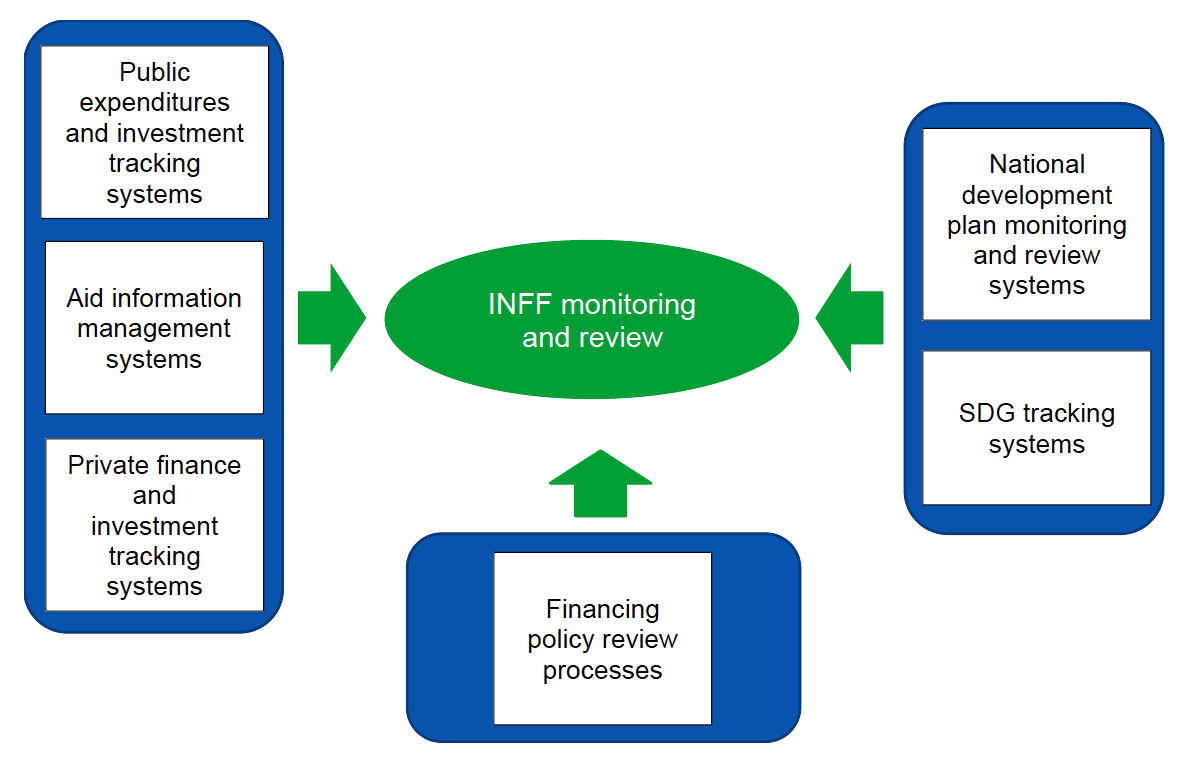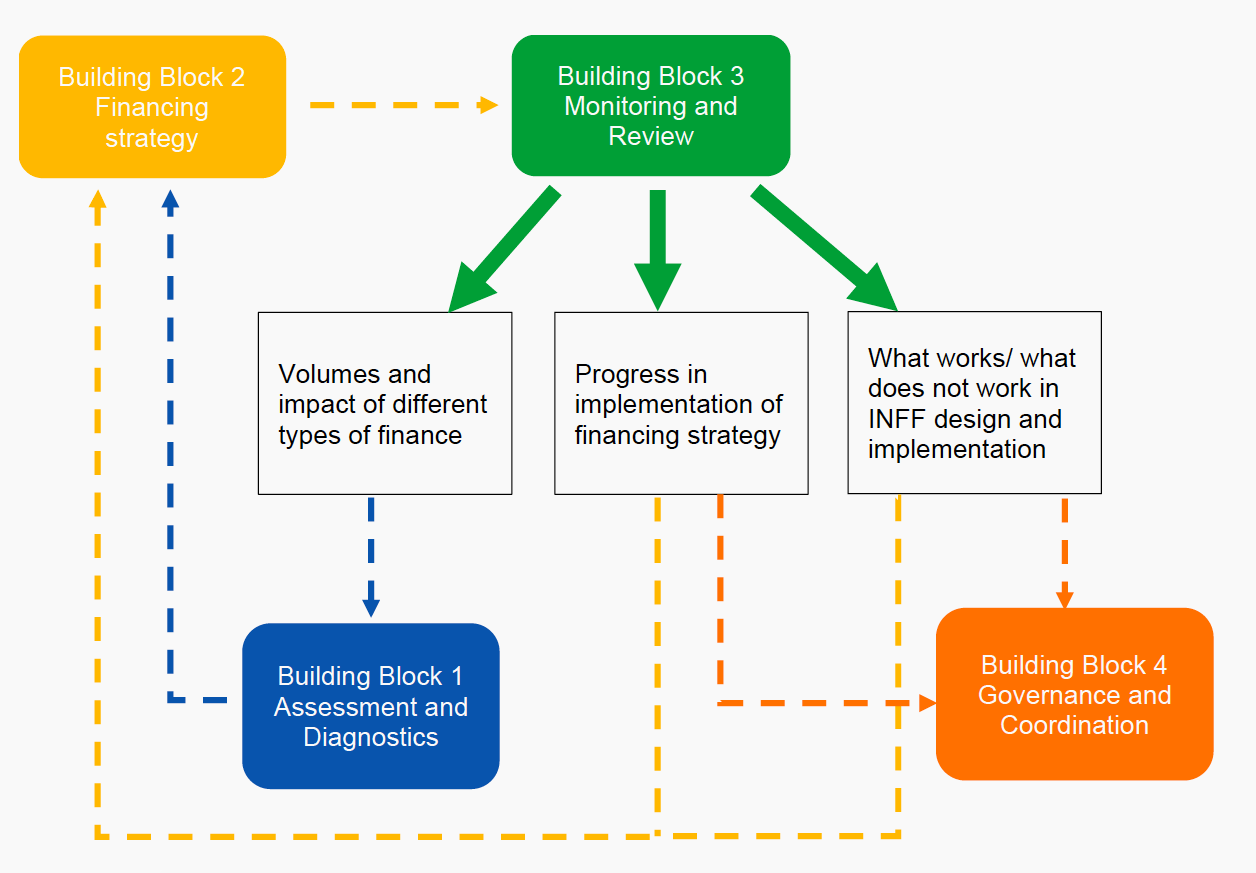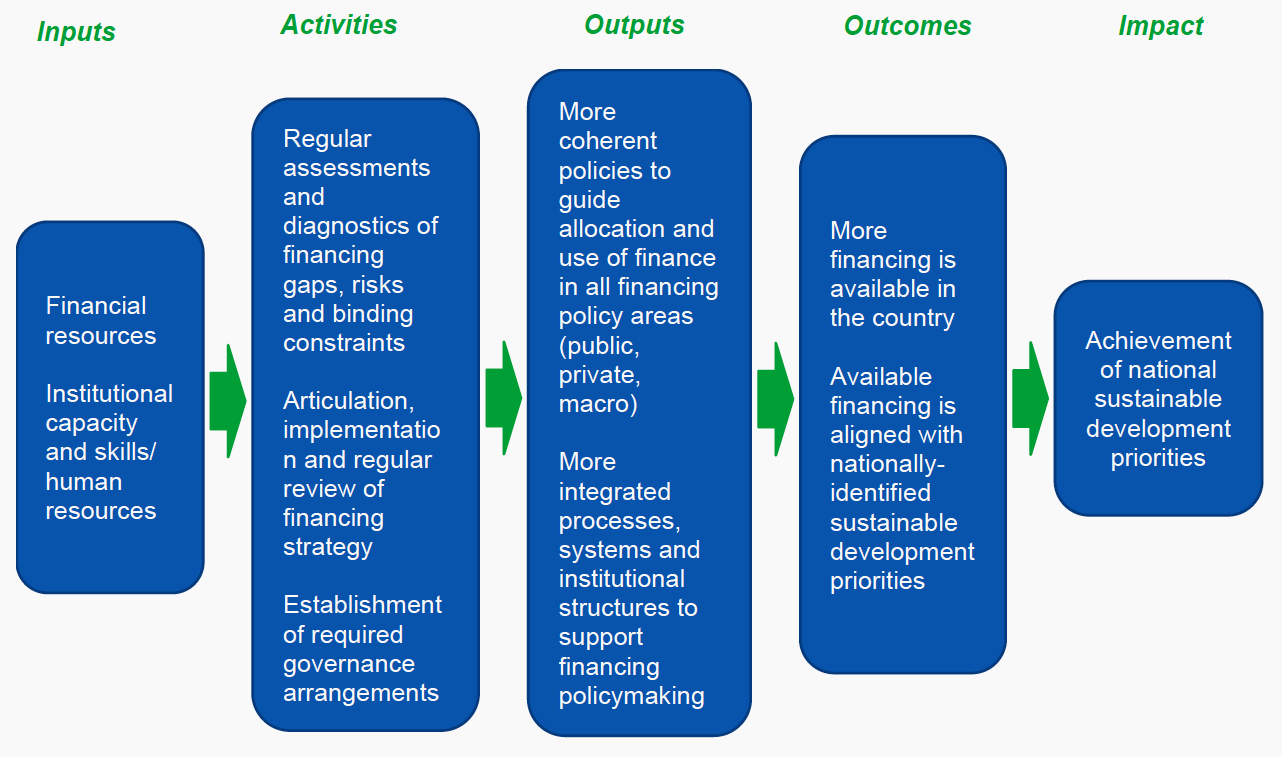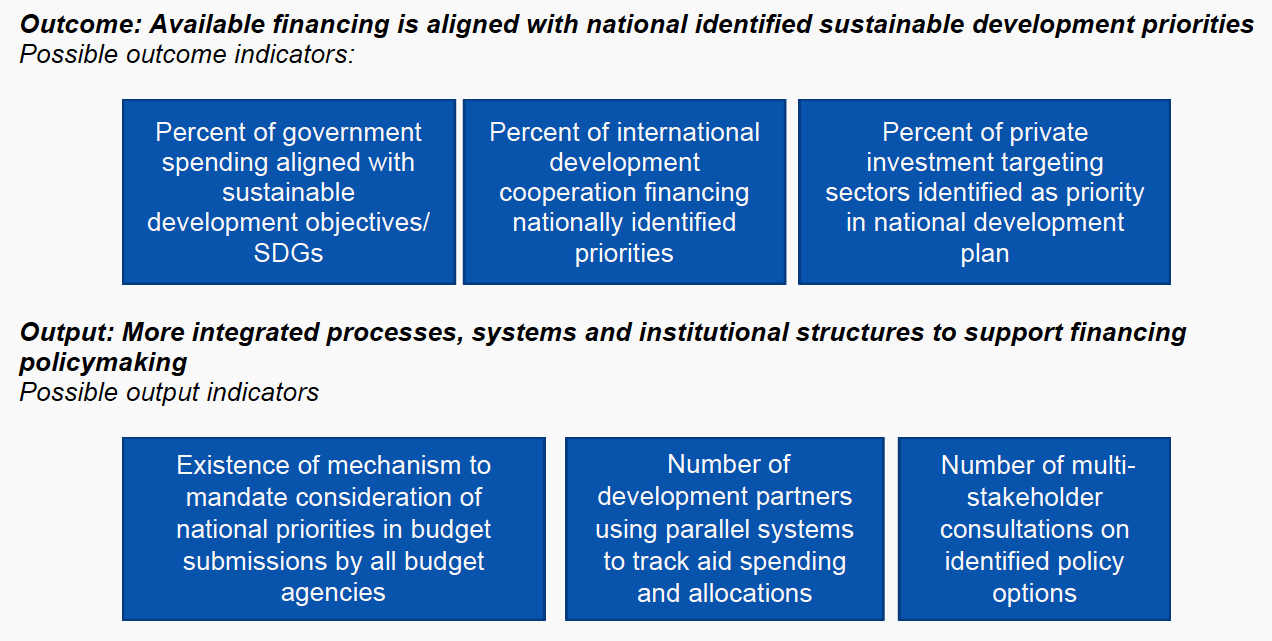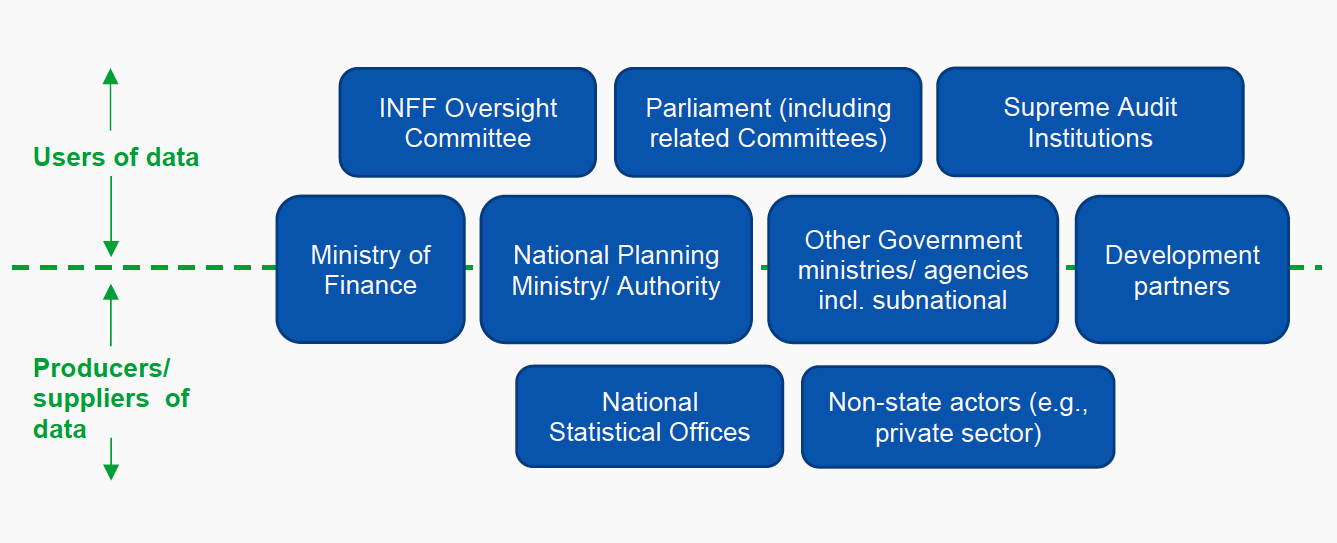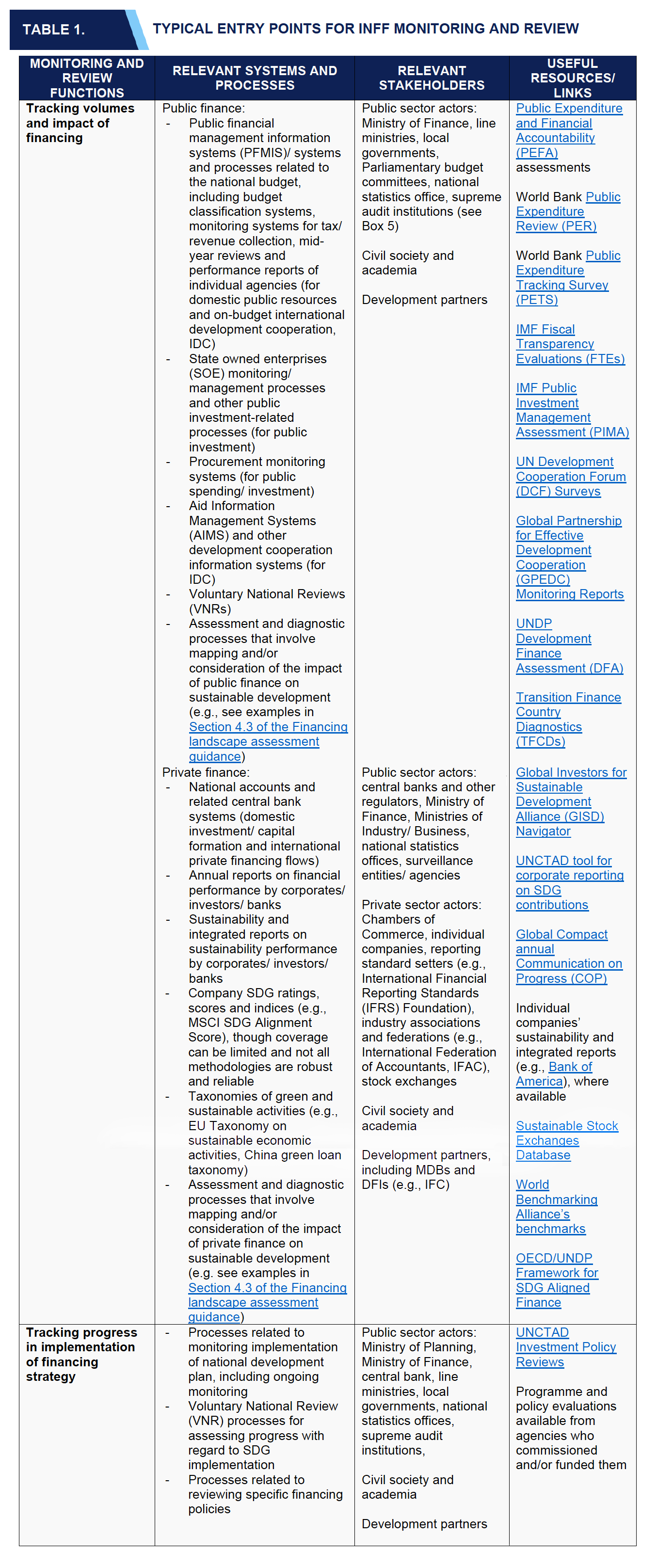Countries do not need to
start from scratch when it comes to INFF monitoring and review. Existing
monitoring systems, processes and frameworks should be the starting point. Such
systems can be strengthened or expanded, better aligned and made more coherent within
an INFF as necessary. Similar to Building Block 4 Governance and Coordination, the overarching aim should be to streamline efforts,
not to replace or duplicate existing systems nor to establish new systems,
unless there are gaps that need to be filled.
Table 1 illustrates potential
entry points for INFF monitoring and review, as well as relevant stakeholders typically
involved in establishing and maintaining adequate systems. It also includes links
to useful resources and tools that can shed light on existing systems and processes.
(Table 2 in Building Block 1.2 Financing Landscape
Assessment provides an overview of
data sources, which can inform the tracking of volumes of financing).
Overall, if a
well-established system for monitoring implementation of the national
development plan is in place, it could serve as a starting point for INFF
monitoring and review. Similarly, if established processes around Voluntary
National Reviews (VNR) exist, these should also be considered (see Box 4). Data
and statistical strategies and reform processes may constitute another entry
point (see more in Section 5.2, Action Area 3). Existing monitoring systems for
different types of finance (such as national budget tracking systems and review
processes, or private finance reporting initiatives) can act as entry points to
build a more comprehensive system. As further articulated in Section 5, the comprehensiveness
of such a system will differ depending on country contexts, reflecting the
nature of INFFs as a long-term and gradual approach to guide better planning
for, and implementation of, financing policy reforms.
With regard to public finance, monitoring
systems relate to government finance (revenue, spending and investment), as
well as development cooperation. Public financial management information
systems (PFMIS) are typical starting points from the government’s perspective. A
growing number of countries have gender, climate, or SDG budget tagging or
coding systems in place, or are developing them as part of their INFF. Monitoring
systems for government finance are usually developed around the annual budget
process, with both volumes and data on performance indicators reported in
relation to objectives that programmes within each budget agency are expected
to achieve on an annual or multi-year basis. In the budget planning and
formulation stage, and as part of their submissions to the Ministry of Finance,
budget agencies may be required to articulate a narrative around how they will
contribute to identified national priorities or the SDGs, and/or to link their
programmes to specific goals. Data on government revenue may be collected to
various degrees of disaggregation and may be subject to review with regard to
questions of progressivity or inequality. There are also varying practices in
relation to monitoring of tax expenditures, used to shed light on revenue
foregone through tax incentives. Specific monitoring frameworks may also be in place
for major investment projects (e.g., articulated by ministries and other
entities involved in major infrastructure projects) and for state-owned
enterprises, which may have dedicated systems to track their investments and
contributions toward national development.
Monitoring systems for development cooperation and
finance are based on national aid information systems and country results
frameworks. According to 2018 GPEDC monitoring data, 96%
of developing countries have one or more information management systems in
place to collect information on development cooperation. While the quality of
such information varies, it typically includes data on financial commitments,
scheduled and actual disbursements, and in some cases on intended and achieved
results. Data from the 2020 DCF survey shows, however, that less than
half of development cooperation information systems tracked results, off-budget
flows, funding gaps and conditionalities. A results framework to review the
performance and results of international development cooperation was in place in
just over half of respondent countries (56%). Critically, in the context of an
INFF, in only 36% of cases countries and development partners use the same, or
mostly overlapping, results framework, meaning that there are multiple parallel
systems. Furthermore, only half of results indicators from development
partners’ projects are monitored using national statistics and monitoring
systems, according to GPEDC data.
With regard to private finance, the monitoring
and reporting landscape is even more fragmented. On financing flow volumes,
national accounts and related central banks reporting are common systems. In
addition, relevant line ministries (e.g., ministries of business or local
development) may have systems in place to collect and report data on
investments in the country, including in relation to the role of SMEs at the
sub-national level. Beyond volumes, policymakers need data and information on
the impact of private business and investment on economic, environmental, and
social issues to assess the private sector’s contribution to sustainable
development objectives. Meaningful data and information on this remains scarce
though a number of initiatives and innovations are ongoing, with INFFs providing
a platform for enhancing coherence of this increasing wealth of information at
the country level and feeding it into financing policy making processes.
For
example, private sector- or government-led systems for consolidating data on
the contributions of business to sustainable development priorities exist in
some countries (e.g., in the Philippines and in Colombia) and
there is a growing number of companies publishing a sustainability report
(mainly large, listed companies). However, information published is often not
comparable across companies or time, and tends to focus on qualitative indicators rather
than on quantitative data. Companies select the issues they choose to
communicate, as sustainability reporting remains largely voluntary. In
addition, sustainability-related information is generally behind paywalls and
is not in the public domain; policymakers could change this by creating an open
repository for company sustainability data to create more transparency. Companies
also need to adjust their internal systems to track and report data on
environmental and social issues. This might be particularly challenging for
smaller companies with limited resources. Nonetheless, voluntary sustainability
reports can be a starting point. Governments can increase their relevance by
agreeing (including at the global level) on harmonized metrics and indicators
to be used for company disclosure. Countries across a range of development
contexts (e.g., EU, China, Mexico, South Africa, Mongolia, Bangladesh) have
developed or are in the process of developing taxonomies that could enhance reporting
on both volumes and impact of private business and finance. The G20 Sustainable
Finance Working Group (SFWG), established in 2021, is also working on improving
corporate sustainability disclosure and on facilitating the compatibility and
consistency of national approaches regarding sustainable taxonomies. The INFF
process can help consider these national and international efforts in connection
to public finance classification systems.
